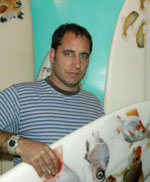Shooting Fish in a Barrel

Dirk Westphal '86 has taken photographs of dogs, people, and food. It's his photographs of fish, however, that have made a splash in the art world. Westphal has had gallery shows in New York and Los Angeles, as well as Aspen, Colorado, and Sydney, Australia, and has been profiled in the New York Times, all because of his piscine obsession.
"It started off as a kind of a lark, where I got these goldfish," says Westphal. "My [photo] studio is in [New York's] Chinatown, and orange is my favorite color." The more he looked at his colorful new pets, the more Westphal thought they were either "really cute" or "the opposite of really cute," with their alien-like bulbous eyes. "They're very far-out looking," the photographer says, "and I couldn't stop looking at them. They're really seductive in a perverse way."
Intrigued, Westphal devised a unique set-up to photograph the fish. "I started building these special tanks and using bigger and bigger cameras to capture more and more detail," he says. "I built a wall of white Plexiglass behind the tank and very precisely balanced the light in the foreground with the light in the background. When you take the picture, the water just disappears-photographically, that is-so you've got these fish floating around in nothing, without any shadows to speak of."
Startlingly detailed, the images seem larger than life. The effect is surreal; it's as if the viewer is encountering these creatures for the first time.
The fish photos were successful, but they were merely one among many of Westphal's ongoing projects until several years ago, when another element was introduced by chance.
"I was having drinks in Australia with this art dealer who shows my work," Westphal explains, "and I was going on about the surfing in Australia, because that is a hobby of mine, and he said, 'Why don't you put those fish on a surfboard?'"
It was a "why didn't I think of that?" moment, but it would take Westphal a while to put it into motion. "I talked to some people in the surf industry, and they said, 'You can't really do that, put photos on a surfboard,'" he says. "The more they said you can't do it, the more interested I became in making it work."
Since he knew nearly nothing about surfboards, Westphal began at the beginning. He ordered foam blanks, which are the cores most boards are made from, and learned to shape them by planing off the outer crust. He developed a special method for gluing the photos onto the blanks, smoothing them out, and wrapping them in fiberglass.
"It's a little bit of a secret as to how I do it, because it took me a long time to figure it out," he says. "In retrospect, what I should have done was first figure out how to get the photos onto the surfboards and then how to make the surfboards as a separate step, but it was all one big project for me."
Westphal thinks of his photo-surfboards as sculptures, although they could be used to ride the waves. "They're actually really good boards, because they're made with structural fiberglass and epoxy resin," he says. "But the price tag [$4,000 and up] kind of dictates their use as art." Rather than risk damaging them in the ocean, buyers mount them on the wall or place them as sculptures (although his "surf pals" have actually used some of the boards in the water).
The potential confusion about whether these pieces are surfboards or artworks, or both, can make things "a bit complicated" for art dealers, Westphal says. But the blurred line between object of art and object of utility "has always been one of those things about art that interests me."
At an exhibition of his surfboards in New York, Westphal used the gallery space to emphasize the process of creation as well as his final artistic product. "I made a little how-to film called How to Make a Surfboard," he explains. "Most people have no idea what fiberglass is, or how [surfboards] come to be. I deconstructed the myth and gave all these tips and tricks I wish someone would have given me." He also demonstrated actual surfboard shaping in a "shack" at the gallery, and made wall-mounted text pieces out of epoxy with "subliminal" messages such as "Free" or "Sold Out."
The do-it-yourself process has long fascinated Westphal, who says there were always cameras lying around the house when he grew up in Columbus, Ohio. He came to Kenyon unsure of what to study and ended up majoring in English. It was photographer Gregory Spaid '68 of the art faculty (and currently the provost) who "inspired me to take photography seriously," says Westphal. "The art of photography was something that he spoke about eloquently and made very interesting."
Westphal went on to get a master of fine arts degree from the California Institute of the Arts, then worked as an assistant to award-winning photojournalist Antonin Kratochvil, "one of the world's black-and-white heavy hitters," traveling with him around the world doing "barebones" street reportage. He found employment as a magazine photographer, contributing to publications such as The Source, ArtNews, the New York Times, and Time-work that he found "great fun" but too trend-oriented. "My artwork had a better value, from a longevity point of view," he says.
Dirk Westphal's artwork may be seen on his Web site, www.dirkwestphal.com.
Do you have feedback on this page?
